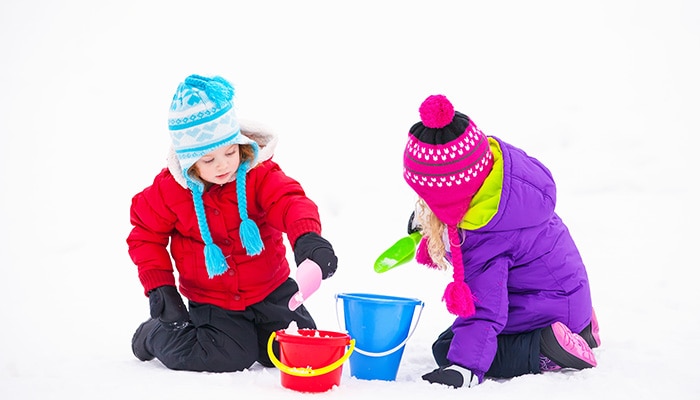While we believe that the books and resources recommended may be of value to you, keep in mind that these are suggestions only and you must do your own due diligence to determine whether the materials are appropriate and suitable for your use. PNC has no sponsorship or endorsement agreement with the authors or publishers of the materials listed.
WINTER

The Big Meltdown
Children will explore melting snow.

Lesson Objective
Children will explore the amount of water that results from snow when its melted.
ScienceArtMusic
What You'll Need
- Buckets – 1 per 4 children
- Shovels or scoops – 1 per child
- Snow – enough to fill each bucket
- Rulers – 1 per group of children
- Markers – 1 per group of children
- Chart paper
What To Do
Note: The children will be working in groups of 4 for this activity.
- Tell the children that they will be working with a small group to explore melting snow.
- Have the children dress for going outdoors.
- Distribute shovels or scoops and buckets.
- Take the children outside, and have them fill their buckets with snow (see Lesson Tips).
- Have the children use a marker to mark the level of the snow on the buckets.
- Bring the buckets inside, and help the children measure the height of the snow in their buckets using the rulers.
- On the chart paper, record the depth of the snow in the buckets.
- Ask the children to predict how much water will be in the bucket once the snow melts; record their predictions.
- Throughout the day, check on the snow in the buckets. Use rulers to measure the water, and write the measurements on the chart paper.
- Compare the results with their predictions (see Did You Know?).
Resources
Home School Resources
Home educators: use these printable lesson PDFs to teach this lesson to your home schoolers. They're available in English and Spanish.
Content Provided By
Common Core State Standards Initiative – These lessons are aligned with the Common Core State Standards ("CCSS"). The CCSS provide a consistent, clear understanding of the concepts and skills children are expected to learn and guide teachers to provide their students with opportunities to gain these important skills and foundational knowledge [1]. Visit the CCSS


